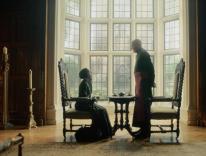TV programs such as "Entertainment Tonight" offer to take you "behind the scenes" and show you how a movie is shot. For Commonweal’s seventy-fifth anniversary, and in anticipation of my tenth year as its film critic, I’d like to take my readers a bit behind the scenes of my reviews. This, I hope, will give you a sense of the place movies occupy in today’s culture, of the current importance and unimportance of film criticism, and, finally, of the specialness of writing for this magazine.
Clearly, I don’t review the majority of released movies, for that’s impossible to do in depth for any biweekly in which space is at a premium. So, how do I choose?
Each film I write about must fall into at least one of three categories: (1) a much discussed work (Schindler’s List, Titanic) which can’t be overlooked without ignoring what’s happening in the culture at large; (2) relatively unpublicized films of quality that should be brought to the reader’s attention (The Rapture, Citizen Ruth); (3) movies that deal directly with religious matters and/or institutions (Priest, Entertaining Angels). Films that can brace the spirit often fall into more than one category. Many popular movies don’t fall into even the first category because, though they’re well attended, there’s nothing in them that can be discussed even by the teen-agers who have made their success. The current hit, Blue Streak, is an instance of this. What’s to talk about?
Trying to be faithful to these criteria, I’ve goofed time and again. If only I had reviewed Braveheart, which, when I finally caught it on video, surprised me as being not only an Oscar-winning blockbuster but a pretty good movie with an emotional kick. And why did I overlook that grime-encrusted gem, One False Move, the best melodrama of the last two decades, and one with some spiritual import as well? Worse still, I failed to write about Breaking the Waves, a troubling, flawed movie but one that featured not only an unforgettable performance by Emily Watson but some real insight into organized religion’s perennial trouble with ecstatics who also seem to be heretics?
Even though I did review most of each year’s major films, readers may have noticed that my reviews have appeared erratically in relation to the time of a movie’s release date. Why did my reviews of The Red Violin and Shine appear as soon as those movies were released while the Titanic and Amistad notices appeared more than a month after their openings?
This brings us right to the question of the function of the movie critic but this entails the even larger subject of the state of the American movie industry. And the larger subject must come first.
There are, broadly speaking, two types of movies nowadays: big-studio movies and less expensive ones made with independent financing (though often released by a major studio when the finished product smells successful). The studio-made jobs (Titanic) cost a gazillion dollars and must "open big," that is, make millions of dollars in their first two weeks if it is to prove financially worthwhile to keep them in wide distribution all over the country (advertising and the manufacture of prints are expensive). Therefore, the publicity machines are cranked up weeks in advance in hope that the resulting "buzz" will be heard by the customers. Though the critics on television, major newspapers, and popular magazines are part of this machinery if their reviews yield exciting quotes, the reviewers of intellectual periodicals are not.
Teen-agers, who make up a huge portion of the audience, are not about to listen to the likes of Stanley Kauffmann (The New Republic), John Simon (The National Review), David Denby (The New Yorker), or myself. Therefore we queue up with the public right after the blockbuster opens. Since I take a week to think and write about each film, my review buzzes through Commonweal’s fax machine about two weeks after the opening (sometimes later, if two or three films are released the same weekend). But since the deadline for the review precedes the magazine’s actual arrival in your mailbox by nearly a month, you can understand the frequent tardiness of my reviews.
On the other hand, independently made American films (Citizen Ruth) and independently released foreign jobs (Shine) are often greatly helped by critical favor. So distributors invite critics to private prerelease screenings often as much as three months before the opening. (Robert Duvall hadn’t even finished editing The Apostle when I saw it.) Therefore, my reviews of these films appear close to release time or even well in advance.
Any irritation this causes the critic is beside the point. What matters is what the current situation reveals about the movie culture of today, especially as compared with the situation of thirty and forty years ago.
From the late fifties till the mid-seventies, great works by Fellini, Antonioni, Bergman, and Kurosawa, along with certain uncommercial American efforts (Shadows, Nothing but a Man) played the art-house circuit. By the mid-sixties, their audiences were large and enthusiastic. And the critics addressing them (Pauline Kael, Stanley Kauffmann, Dwight Macdonald, Andrew Sarris, John Simon, Parker Tyler) had such a sizable following that they were frequently invited to be on talk shows with Dick Cavett, David Susskind, and David Frost, thereby obtaining even larger audiences for both their writings and the movies written about.
The usual demographics became confounded (exactly what should happen to demographics). My father, a truck driver who never finished high school, took me to showings of 8 1/2, Sundays and Cybelle, The Seventh Seal, and Divorce, Italian Style at the Lincoln Theater in New Haven, and knew some of the works of Fellini and Bergman as well as many professors did. His favorite actor was Marcello Mastroianni, and he raved about the beauty of Catherine Deneuve in Belle de Jour. This was not cultural social climbing but direct, honest appreciation of the real fun that was in these movies: their lithe storytelling, their (then) daring frankness about sex, their often explosive humor, deeply felt passion, and the fact that their staging and photography were completely lacking in the high-priced ponderousness and flabbiness that then filled American screens. (There was also the travelogue factor: He got to see much of Europe secondhand.)
"Arty" usually means pretentious, precious, and highbrow in the worst sense. But these "arty" movies of the late fifties and sixties were almost mainstream entertainment, so much delight did they give to a relatively large number of people. Like the novels of Fitzgerald, Hemingway, Faulkner, Willa Cather, and Edith Wharton in an earlier era, here was high art that reached the greater American public. As in all healthy artistic eras, the general public and the intellectually privileged were looking at the same things.
oday, I open the entertainment section of the newspaper and run my eyes down the list of thirteen films at the nearby multiplex that exhibits nothing but big-studio releases. Out of the thirteen, three-Bowfinger, Mumford, The Sixth Sense-are certainly worth reviewing, the first two being comedies with attractively eccentric premises, bright scripts, and good casts, and the third (which I’ve already reviewed) a horror movie with a familiar situation (ghosts frighten child) that is freshened and subtilized by brilliant filmmaking and an amazing performance by the child lead. The ten others are assembly-line jobs that you’ve seen before even if you haven’t seen them before: male models pretending to be actors aspiring to be action heroes; monster sharks, monster bats, monster teen-agers; bedeviled women exorcised by priests with sensitively Celtic profiles; cagy black scam artists not always played by Eddie Murphy.
Over at the local "quality" theater, there are five independently made and distributed features. Two of them are gay comedies about young people coming out of the closet and sending their stuffy and sexually repressed parents into tailspins. There are, by my most conservative estimate, 947 of these gay-pride movies made every year, and I can’t think of a genre that has become so cliché-ridden in so short a time. Also on view are My Life So Far, a modest and pleasant comedy, and Xiu Xiu: The Sent Down Girl, an equally modest and worthy character study set in modern China. The fifth film is a refreshingly immodest French movie, The Lovers on the Bridge, that mixes grunge and lyricism with surprising success.
What sixteen out of these eighteen films have in common is that you might as well wait for the video. On your TV screen the modest comedies will still modestly amuse you and the modest dramas will still modestly touch you, and the cinematic junk will become video garbage. Only The Lovers on the Bridge, with its camera pyrotechnics and outsized emotions, and The Sixth Sense, which can fill an entire theater with its compassionate dread, demand the big screen. (Since writing this I’ve seen Three Kings and would add this exciting mutation of the soldier-of-fortune adventure story to the list.)
What makes this the best of times and the worst of times for movie lovers is one fact: Everything winds up as a video. It’s the best of times because great cinema can now be packaged and bought (or borrowed from libraries) in the same way that great literature can. It gives me a small but distinct thrill to see Bresson’s A Man Escaped and Olivier’s Henry V sitting on my bookshelf not far from books by Willa Cather and Joseph Conrad. I can even browse through these movies now by fast-forwarding in the same way that I thumb through a favorite novel.
Yet it’s the worst of times, too. Neither A Man Escaped nor Henry V was intended by its maker to be shown on a TV screen in a living room for the benefit of two or three people. The ascetic Bresson work and the rabble-rousing Olivier film were both intended for audiences in an auditorium and were meant to cause that electrifying chain reaction that only audiences feel. Their greatness persists in video format, of course, but in the rerun houses of the sixties and seventies, the excitement great old movies sparked in audiences somehow certified and enhanced the excitement being provoked by the new ones. In 1972, you may have loved the wedding celebration that opened The Godfather, but you loved it more when you realized that it was inspired by the layered beauty of the ball in Visconti’s The Leopard. And you were able to make the connection because you could take in The Leopard at the rerun house around the block from where The Godfather was playing. It was like seeing the work of an exciting new painter at a gallery and then popping into a museum to see the new artist’s classic influences. A tradition was being carried on before your eyes.
hat community of filmgoers is no longer. The classic past exists on video which, ideally, should make it available to anybody with a video player. But, in fact, the video revolution has pushed the classics underground. Few video stores stock a great number of them and the ones that are available are often shelved in obscure corners. (Libraries can be much better sources but they need movie-savvy librarians to order unusual titles and, of course, an adequate budget that hasn’t been depleted by buying top-of-the-line computer equipment.) Film buffs will seek them out just as they seek out the few theaters left that run the best independent and foreign movies. What we have now are essentially two audiences: the mass audience which has heard about only the megahits, and the cognoscenti who seek out the classics and the best of the new stuff in theaters and on video and occasionally bestow their business on some out-of-the-ordinary popular entertainment such as American Beauty. But such crossovers are in one direction only. Thirty years ago, Catherine Deneuve was as well known as Audrey Hepburn. Today, the Chinese Gong Li is as drop-dead gorgeous as Deneuve and an even better actress, but it’s a rare moviegoer outside New York or Los Angeles who knows her name. Gerard Depardieu does have the international clout Mastroianni once had, but do you really believe that the percentage of the American audience that knows his non-Hollywood work is as sizable as the percentage that had seen Mastroianni in La Dolce Vita? In short, the general public and the intellectually curious are not enjoying, not even looking at, the same things. (Interestingly, certain TV programs can now draw both audiences-I’m thinking of "Seinfeld" and "Law and Order.")
Consequently, the larger audience’s ability to recognize movies of quality dissipates while the supposedly better-educated audience acquires a decadent edge. Rightly searching for thrills and grandeur, the kids at the multiplexes (and they are mostly kids) are being offered stories in which the literal explosiveness (gunfire, bombings, mutilations, sheer noise) is supposed to make up for the lack of emotional resonance. But it doesn’t, and occasionally the audience sends a message to the filmmakers that it doesn’t. I wasn’t one of those besotted by Titanic, but I feel sympathetic toward the high school girls who made up such a large part of its audience. They were returning four, five, six times, not to watch a ship sink but to see a young Adonis called Leonardo die for love, which is exactly what the Adonises of mythology and literature are created to do. Those girls were yearning for emotional size, not for more and more garish effects. (Case in point: On the day Titanic was released on video, I was browsing through a Tower Records in New York City and noticed four nymphs gazing adoringly up at a video monitor showing the newest release. These children had cut school-a Catholic school, no less- to watch, on a tiny screen, washed out by the late morning light coming through the windows, Leonardo swoon once again into icy waters for the sake of his beloved Kate. I’m willing to wager they had seen the film on the big screen at least a dozen times. But it was pathos, not spectacle, they were hungry for.)
Over at the smaller theaters, the audiences from the universities and the upper middle class are given, on the one hand, burnished renderings of E.M. Forster, Oscar Wilde, Henry James, and, on the other hand, supposedly "cutting-edge" independent American films, like the one in which a young woman expresses her inner self by making love to corpses. I’ve enjoyed and praised in these pages both the "Masterpiece Theater" posh jobs and the grainier stuff of independent release but, too often, both categories brandish the same mistake: the subject matter-grungy or elegant- is supposed to make up for the lack of true innovation in the filmmaking. In the sixties and seventies, the great directors didn’t adopt Henry James and James Joyce. No, they were the Jameses and Joyces of a new medium, and they didn’t coast on explicit violence and perverted sex, because they were more interested in the turmoil within, not surface sensationalism.
For the true critic, the critic I’m still trying to become, the past is not a crutch for the reminiscing sorehead who beats the present over the head with it. Rather, the best of the past is the source for revolt against trendiness. Artists (or at least artist types) who pride themselves on being nonconformist often submit to their own brand of conformity. How many young American scriptwriters are slavishly aping the narrative strategies of Quentin Tarantino, and how many others are loading their screenplays with "bright" dialogue that would sound better in an episode of "Friends" or "Just Shoot Me"? To me, all trends are suspect, especially the "subversive" ones, the ones that "push the envelope" or that belong to "the cutting edge." (Why are all these phrases so bullying?)
Given all of the above, what better platform could I be granted than a column in Commonweal, which has always cast a cold eye on all trendiness within the church and within the culture at large? Better still, this magazine also views with suspicion the instant rejection of innovation. Has there ever been another publication-secular or religious-that so consistently refuses to push the reader’s buttons, though I’m sure that if there were a button marked "look closer," Commonweal would press it all the time.
I would like to think that I have located this button in a few readers and pressed it quite often.
Please email comments to [email protected] and join the conversation on our Facebook page.
Share
Previous Story
Seventy-five years!
Next Story
Commonweal Confronts the Century


